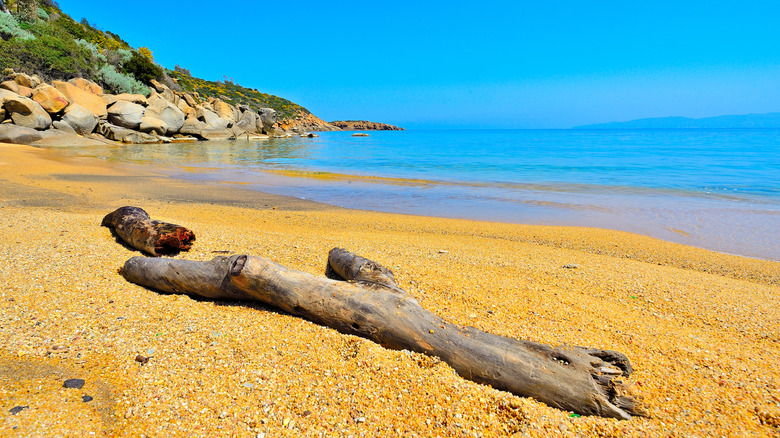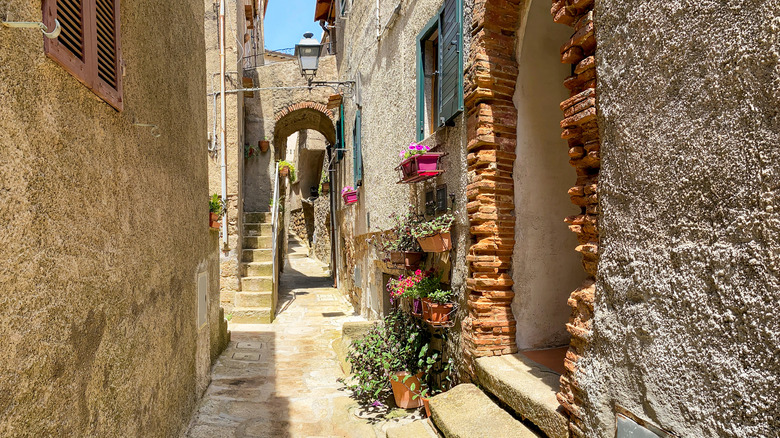Explore Italy's Hidden Island Known For Its Medieval Villages And Olive Groves
With tourism in Italy rebounding to near pre-pandemic levels, it's getting increasingly difficult to discover underrated Italian destinations — those little-known pockets of authenticity that haven't been entirely overrun by enthusiastic selfie-taking visitors. But one tiny island off the coast of Tuscany fits the bill for anyone seeking a quiet Italian getaway away from the madding crowds. Isola del Giglio (pronounced Jeel-yo) is located about an hour by ferry from Porto Santo Stefano, a fishing village two hours northwest of Rome, and it's a world away from the 24/7 bustle of Italy's major tourism centers.
Life moves at a more relaxed pace on the second-largest island in the Tuscan Archipelago (Elba is the largest), and Isola del Giglio's treasures include medieval villages and gorgeous beaches. Then there's the more recent restoration of the island's age-old olive groves. Its hilly terrain and strict regulations make it difficult for visitors to bring cars to the island, so pack a good pair of walking shoes and get ready to explore the landscape. At only about nine square miles, it's possible to walk from one end of the island to the other in a couple of hours. Not into hiking? Other ways to get around include taxis, buses, and rental vehicles including cars, scooters, and e-bikes.
Daytrippers may want to spend their entire visit to Giglio exploring the port town where the ferry docks. Located mid-coast on the island's eastern shoreline, Giglio Porto is the commercial hub of the island. Shops and restaurants line the harborside promenade. Significant landmarks within walking distance of the ferry dock include Torre del Saraceno, a watch tower built to protect the port from pirate raids. Another medieval tower, Torre del Lazzaretto, was built on the orders of Cosimo de' Medici, the first grand duke of Tuscany.
The island village known for its stunning sunsets
On a hot day, stroll north on the promenade of Giglio Porto to where it ends at Hotel La Guardia. The 29-room Michelin-rated hotel sits on a small public beach. Go for a swim, then relax and take in the view from Terrazza La Guardia, the hotel's waterfront restaurant. Two of the island's top-rated beaches are within easy reach for daytrippers. Hail a taxi boat near the ferry dock or hitch a ride on the beach shuttle.
Located a little more than a mile from Giglio Porto — you can get there by land, but water taxi is more fun — Cannelle Beach is known for white sand and calm water. Caldane Beach, the smallest beach on the island, is accessible only by water taxi or by hiking along a dirt path that starts at Cannelle Beach. The hike along the scrub-lined trail is challenging, but the end of the path reveals an often-deserted beach with unspoiled views of the Mediterranean. Further afield, Campese Beach, the largest beach on Isola del Giglio, is located in the resort town of Giglio Campese, about five miles from Giglio Porto. On the island's west coast, Campese Beach is a gathering spot for sunset lovers. It probably doesn't hurt that it's lined with bars and restaurants, some featuring live music.
In addition to its stunning beach, Giglio Campese is home to Torre del Campese. This fortified watchtower on the shores of the Tyrrhenian Sea (the arm of the Mediterranean Sea between the coast of Italy and the Tuscan Archipelago), perches on a rocky promenade connected by a bridge to Isola del Giglio. Dating back to 1600, the tower and surrounding complex — including landscaped gardens and three vacation apartments — are currently under private ownership.
Isola del Giglio is home to one of Italy's most beautiful villages
Before leaving Giglio Campese, consider a short hike to Faraglione. The oft-photographed monolithic rock formation juts dramatically from the surface of the ocean, rising five stories above the Tyrrhenian Sea. The 2.1-mile round-trip trail begins at the beach near the Campese Diving Center. The relatively easy hike to a viewing platform overlooking Faraglione can be completed in about an hour. Another option? Book a boat tour and explore the stunning formation from sea level.
The highest community on Isola del Giglio, the medieval town of Giglio Castello is perched 1,600 feet above sea level. Italy is home to many beautiful medieval villages, and this one is exceptional — this walled village, where narrow streets connect public squares, is considered to be one of Italy's most beautiful. Like many of Italy's surviving medieval villages, Giglio Castello hasn't changed much through the centuries. It's a place where a stroll along narrow alleys and steep rock-carved steps reveals the brightly colored doorways to centuries-old homes. Aldobrandesca Fortress (also known as Rocca Pisana) presides over the fortified village. The imposing structure has, at different times, served as a fortress, private residence, and even a prison. There's an on-site museum (admission is free) and visitors can climb the tower to take in expansive views across the sea to Mount Amiata in southern Tuscany.
End your day at Ristorante di Santi. A short walk from the fortress, the restaurant's al fresco deck is a dreamy place to watch the sun setting on the horizon while sipping a glass of local wine.
Savor the taste of Isola del Giglio
Speaking of wine, Giglio Castello is in the heart of the island's wine country. Viticulture is a long-standing tradition on Isola del Giglio, especially at higher elevations where the rocky, acidic soil and warm sun combine to produce ideal growing conditions for Ansonica grapes. Even in the 21st century, winemakers still produce wine according to methods passed down through generations, including harvesting grapes by hand. Also known as Inzolia, the Italian grape native to Tuscany and Sicily has long been the grape of choice for Italian fortified wines, but vintners are beginning to produce a lighter, crisper dry white wine, sometimes said to have citrus and herbal notes with hints of flowers and honey. Fancy or bottle or two for your personal cellar? Make sure you know all the tricks for bringing European wine back to the U.S. after your vacation.
Wine isn't the only culinary treasure produced on Giglio. The island's olive groves, some dormant since tourism became the central focus of the local economy in the 1960s, are experiencing a revival as farmers, like Francesco Bancalà, attempt to restore ancient olive trees and resume production of olive oil. So far, so good. Bancalà, whose property encompasses olive groves his great-grandfather planted, reaped the rewards of his labor when he and his team hauled in their first harvest in 2021.



